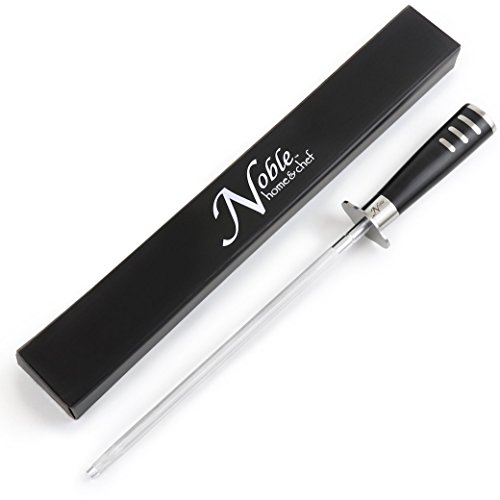Honing Rod vs. Sharpening Steel
Honing rods seem a lot more like sharpeners, but they are different. In most cases, users confuse both and end up going wrong. Generally, honing steel helps to realign and straighten edges for a better cut. But without care, they may cause damage. To prevent particles from landing on your food or getting right into your nostrils while honing, you need this rod. If you didn’t already know, honing a knife is not the same as sharpening. A honing rod straightens while sharpening sharpens (literally). You may find your piece losing some bits of metal during honing, but still, it is meant for straightening. If you’re new to the market, chances are high you’ll need an ultimate guide such as this. Keep scrolling, and you’ll find all you need to know. But here, we’ll tell you just what you need to know about both tools and their differences.
Sharpening steel
Sharpening steels work just as their name suggests—for sharpening. Simply, they get rid of materials from your knife and keep it edged. By sliding your tool through the steel, you restore it to its V-shaped form. It works particularly for blunt knives and helps you get them in shape. If you’re stuck with a dead knife or you have quite a lot of razor tools with blunt edges, this is for you. However, you should ensure not to use sharpeners on an overly frequent basis. Daily sharpening of your kitchen knife may cause it to lose its blade.
Honing rod
Unlike sharpeners, honing rods are used to restore bent edges. They fix your knives and make them look straight again—call them your tool straightener. With a honing rod, you can utilize curved kitchen tools, get them in shape, and make them work their best. The difference is in the function. While sharpeners take off metal particles, honing rods do not—they are made essentially for straightening and may not edge on your knife. Mostly, sharpeners are ceramic with a little bit of diamond (as a coating). So they tend to be tougher and more solid.
How To Use the Honing Rod
Adulthood starts when your counter features a knife set. By then, you can boast of complete kitchen space and an official entry into the stellar. But how exactly do you keep your tools? For one, the kitchen knife needs frequent cleaning to last long. However, it may require some honing too. Kitchen knives are hardly ever effective without the rods, and as you may know, honing rods helps to keep blades and also maintain a tip-top shape. They work much unlike straighteners and may not remove fibers. If you’re looking to buy a honing rod for your knives this time, check out this guide. Here, you’ll find tips on how to use rods in the best way possible:
Step 1: Look out for correct angles
Honing your knife at the right spot is essential if you’re going to enjoy cutting. Wrong angling produces wrong results and may end up ruining the blade. You should hold on to the rod with your less dominant hand while planting the tip right into the cutting board. Next, place your knife’s heel gently against the steel at an angle of about 20 degrees. You may want to hold the knife at right angles to your honing rod and then reduce it (twice) by half to get the right angle.
Step 2: Start honing
With the same angle, draw your knife through the steel’s length and apply light pressure. Ensure you pull it across the entire length (of the blade) till its tip meets that of the rod. Stroke gently and steadily, but avoid excessive pressure--extra speed or force may damage your knife. Repeat the process and ensure the knife gets honed (you may go 3 to 5 moves per side).
Step 3: Check knife edges
At this point, your knife must be completely honed. Get a plain sheet and slice through it to check for its effectiveness. If the paper slices easily and without wrinkles, then you’re good to go. A well-honed knife must stay fit and maintain a straight form.
How To Clean Your Honing Rod
Most premium sharpening systems today come with extra oil for honing. So if you own one, you’re in luck. Simply clean up your rods and apply oil for care. For the best results, you may add drops of oil to your honing rods and allow metal shavings to drop. After that, you wipe them away. With this method, you can clean up any of the best honing rods on the market and keep them intact. If you’re in want of oil, you may try warm water with some little drops of dish soap. This also works to lift shavings and helps you wipe the rods.
Factors To Consider When Choosing Honing Rods
Material
Regardless of what it feels like on the outside, your honing rod must come with a metal core. The material must be tough and durable enough to withstand use. If you’re buying for the first time, then you may want to check rods with about 65 HRC steel ratings. This would, of course, last a long time and guarantee a reduced level of wearing.
Shape
Honing rods may be flat, round, or oval. So depending on your choice and your budget, pick steels that serve your particular home purpose. Besides material, the shape is also important, and it varies from rod to rod.
Size
Not all honing rods work for all knives. As the knives vary, so also do the rods. When choosing steel, consider your knife’s size and also the size of your rod. Buy rods that suit your knife’s size and work just for you. The size or length of rods will depend on the knife's length, but ensure they’re not shorter.





